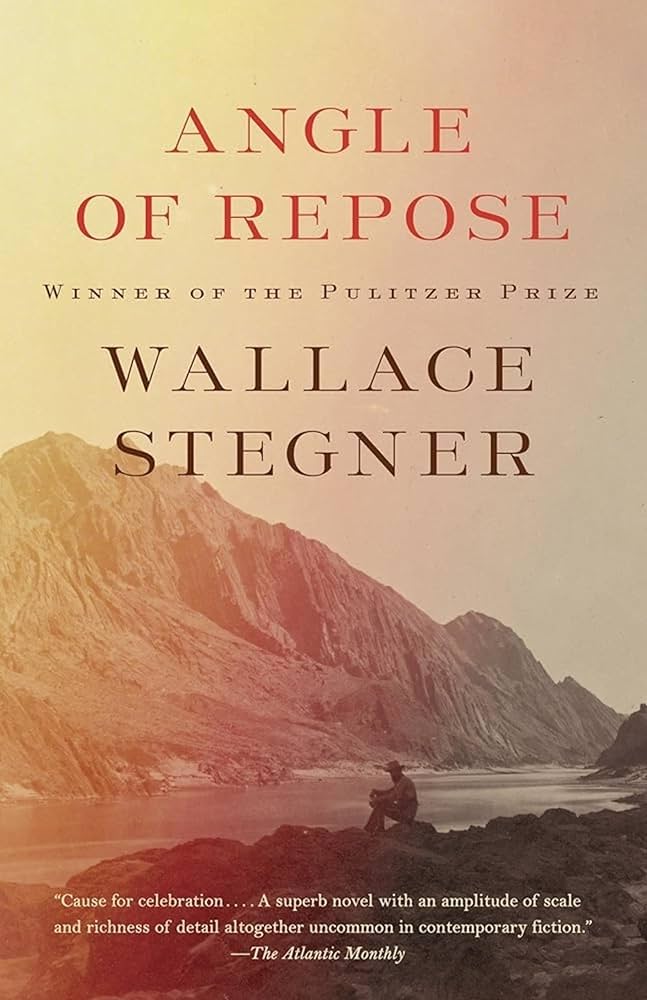In the sprawling landscapes of American literature, few works capture the delicate interplay between personal history and the broader sweep of time quite like Wallace Stegner’s *Angle of Repose*. This novel, celebrated for its intricate storytelling and vivid portrayal of the American West, invites readers to explore themes of memory, resilience, and the search for equilibrium in a constantly shifting world. In **, we delve into the layers of Stegner’s narrative craftsmanship, examining how the novel balances the intimate with the expansive, the past with the present, and ultimately, the human desire for stability amidst change.
Exploring the Fragile Dance Between Past and Present in Wallace Stegner’s Angle of Repose

Wallace Stegner’s narrative masterfully weaves together the threads of history and memory, creating a literary tapestry where the past does not simply linger-it actively shapes the present. Through the lens of the novel’s characters,readers witness the delicate balance between honoring ancestral struggles and confronting contemporary challenges. this interplay is not static; it breathes and shifts, much like the geological concept of “angle of repose” that anchors the title-where stability is found at the brink of movement, tension, and eventual change. The novel invites us to ponder how personal and collective histories are continually reconstructed, reminding us that our understanding of the present is often a reflection refracted through layers of memory, loss, and hope.
Stegner’s prose elegantly captures the fragility of this temporal dance, where moments of clarity and confusion coexist. His characters reveal how legacy can serve as both a foundation and a burden, influencing identity and decision-making. Through themes such as:
- Migration and settlement-the pursuit of new beginnings shadowed by old wounds,
- Innovation versus tradition-striving to build while respecting the past,
- Memory’s selective nature-what is preserved, altered, or forgotten over time,
Stegner crafts a nuanced exploration of how individuals navigate the precarious slope between where thay come from and where they are going.
| element | Symbolism | Impact on Narrative |
|---|---|---|
| Angle of Repose | Balance between stability & change | Represents tension in personal & historical contexts |
| Letters & journals | Bridging past & present | Provide insight & perspective on family legacy |
| Western frontier | Opportunity & hardship | Backdrop for conflict between progress & preservation |
A Deep Dive into the Complex characterization that shapes the Emotional Heart of the Novel

Wallace Stegner masterfully crafts characters that resonate with subtle complexity and emotional depth, inviting readers to explore the nuanced layers of human experience. At the core is Lyman Ward, whose reflective journey anchors the narrative, peeling back the layers of his grandfather’s past while grappling with his own search for meaning and connection. The novel’s characters are not merely figures in a historical tableau; they are imbued with contradictions and silent yearnings, their flaws and desires gently illuminated through Stegner’s delicate prose. This intricate character progress encourages us to rethink how personal history and identity intertwine, making each character’s emotional arc a vital thread in the fabric of the story.
what stands out is the blend of resilience and vulnerability that Stegner weaves through his protagonists.Consider the following qualities that define their emotional core:
- Endurance: The characters’ ability to persist amid hardship reflects not just physical strength but profound emotional steadiness.
- Isolation: A recurring emotional state that shapes their internal dialogues and relationships.
- Yearning for Connection: Despite periods of solitude, there is an unmistakable quest for understanding and belonging.
| Character | Dominant Trait | Emotional Challenge |
|---|---|---|
| Lyman Ward | reflective | Reconciling Past and Present |
| Susan Burling Ward | Resolute | Maintaining Independence |
| Oliver Ward | Stubborn | Accepting Change |
This amalgamation of traits intricately shapes the novel’s emotional landscape, allowing Stegner to balance historical narrative with intimate psychological insight. It is this delicate interplay that ultimately forms the emotional heart of Angle of Repose, taking readers on a journey both external and deeply internal.
How Stegner’s Use of Landscape Elevates the Story’s Themes of Change and Stability

Stegner’s vivid depiction of the American West serves as more than just a backdrop; it becomes a living, breathing entity that mirrors the novel’s exploration of change and permanence. The landscape, with its vast plains, rugged mountains, and shifting light, embodies the tension between the relentless passage of time and the enduring qualities of place. Through detailed descriptions, Stegner captures the natural environment’s cyclical patterns-seasons changing, rivers carving new paths-drawing a parallel to his characters’ struggles to adapt while rooting themselves in history and identity.
This interplay is further highlighted in the way Stegner contrasts elements of the landscape that symbolize stability with those representing change. Consider the following table, which illustrates how different natural features correspond to the novel’s thematic dualities:
| Landscape Element | Symbolizes Change | Symbolizes Stability |
|---|---|---|
| Rivers | Constant movement and change in course | Source of life and continuity for settlements |
| Mountains | Erosion and weathering reshape their form | Timeless guardians of the land |
| Prairies | Subject to seasonal cycles and human cultivation | Expansive, unchanging horizons |
Stegner’s masterful use of landscape not only enriches the narrative’s emotional depth but also invites readers to reflect on the delicate balance between embracing change and honoring stability-a theme that resonates profoundly throughout the novel’s unfolding.
Unpacking the Narrative Structure: Letters, Memories, and the Art of Storytelling
The novel’s narrative unfolds through a tapestry of letters and memories, weaving together past and present in a manner that both challenges and rewards the reader. Stegner masterfully employs correspondence as a lens through which the inner lives and external realities of his characters are revealed. These letters act not merely as plot devices but as intimate windows that bring history to life, transforming fragmented recollections into a coherent and emotionally resonant story. The interplay between the epistolary form and flashbacks creates a rhythm that encourages reflection, allowing the nuances of each character’s journey to surface gradually rather than through straightforward exposition.
Key elements of this narrative approach include:
- Dual timelines that intersect to deepen understanding.
- Unreliable narration, which invites readers to question and interpret.
- Thematic resonance between historical context and personal experience.
To illustrate the balance Stegner strikes, consider the way he juxtaposes longing and pragmatism through his character’s written reflections:
| Letter | Emotional Underpinning | Historical Context |
|---|---|---|
| From Susan to Oliver | Doubt and hope intertwined | Westward expansion challenges |
| From Oliver to Susan | Anchored resolve with hidden fear | Industrial innovation era |
This layered storytelling enriches the narrative, allowing Stegner not only to capture the factual weight of historical events but to delve into the emotional truths that frequently enough go untold. the letter format, coupled with memory’s selective gaze, gives the novel a timeless quality-a meditation on how stories are constructed and preserved across generations.
The Role of Gender and Ambition in the Lives of Stegner’s Pioneering Characters
Wallace Stegner’s characters in Angle of Repose embody a complex interplay between gender expectations and the drive to carve out individual ambition. Women, often constrained by societal norms of the late 19th and early 20th centuries, navigate ambitions not only within the domestic sphere but also in realms traditionally dominated by men. Through Susan Burling Ward, Stegner crafts a pioneering figure who exemplifies how a woman’s resolve can quietly reshape her world, challenging the boundaries imposed on her gender without overt rebellion.Her ambition is woven into everyday acts of resilience and adaptation-highlighting an internal strength as formidable as any outward enterprise.
The men in the narrative, meanwhile, grapple with the pressure to uphold frontier ideals of rugged individualism while confronting their vulnerabilities, often found at odds with their spouses’ aspirations. This dynamic tension reveals a multi-faceted portrait of ambition where success is not merely professional or economic but deeply personal and relational. Consider this breakdown of ambitions portrayed in the novel:
| Character | Gender Role | Type of Ambition | impact on Relationships |
|---|---|---|---|
| Susan Burling Ward | Female | Emotional & Practical Independence | Balancing support and self-identity |
| Oliver ward | Male | Professional Achievement & Legacy | Occasional emotional distance |
| Other Pioneers | Mixed | Survival & Expansion | Frequent personal sacrifices |
- Gender norms act as both constraint and catalyst for ambition.
- Ambition is portrayed as multifaceted-not just a quest for success but also for meaning and connection.
- Balancing personal desires with societal expectations creates rich internal conflicts.
Balancing Historical Accuracy with Literary imagination in Portraying the American West
Wallace Stegner’s Angle of Repose masterfully navigates the delicate interplay between historical authenticity and the creative liberties of storytelling. Through meticulous research, Stegner breathes life into the dusty trails and rugged landscapes of the American west without sacrificing narrative allure. His portrayal of complex characters, deeply rooted in the realities of their time, elevates the historical backdrop from mere setting to an active participant in the story. This balance invites readers to immerse themselves in a world where facts inform imagination,fostering a richer,more nuanced understanding of frontier life.
The novel’s strength also lies in its ability to highlight inherent tensions between accuracy and artistic interpretation. Stegner neither idealizes nor romanticizes the West; instead, he presents it with all its harshness and contradictions. Key elements that underscore this balance include:
- Authentic period details: From the minutiae of 19th-century engineering techniques to the vernacular speech of settlers.
- Emotional depth: Inner conflicts and personal resilience that transcend historical events.
- Layered narrative structure: Shifting perspectives that enrich the factual context without overwhelming the plot.
| Aspect | Historical Precision | Literary Imagination |
|---|---|---|
| Setting | Real frontier towns and landscapes | Symbolic use of environment to reflect internal states |
| Characters | Based on real historical figures | Created composite personalities for depth |
| Plot | Anchored in documented events | Incorporates imagined personal dramas |
Themes of Isolation and Connection: What Angle of Repose Reveals About Human Relationships
Within Angle of Repose, Stegner intricately weaves a tapestry that captures the delicate tension between solitude and companionship. The characters frequently enough find themselves physically isolated by the vast Western landscapes, yet emotionally tethered through letters, memories, and the enduring weight of their relationships. This duality invites readers to reflect on how isolation can be both a sanctuary and a prison, shaping personal identity and forging unexpected connections. Through Susan and her grandfather’s story, the novel gently probes the paradox that sometimes distance can deepen emotional intimacy, while proximity might breed misunderstanding.
Stegner’s portrayal of human relationships emphasizes subtle complexities, shown through:
- Unspoken bonds: Moments where silence speaks louder than words.
- Fragile dependencies: The fine line between reliance and detachment.
- Resilient hope: How connection endures even in adversity.
| Aspect | Reflection in the Novel |
|---|---|
| Isolation | Physical remoteness, emotional solitude |
| Connection | Letters, memory, shared history |
| Balance | Finding peace between solitude and togetherness |
The Influence of Personal Experience and Biography on Stegner’s Writing Style and Content
Wallace Stegner’s narrative voice in Angle of Repose is deeply intertwined with his own life journey, creating a rich tapestry where personal experience informs every layer of storytelling. His years spent in the American West, coupled with his academic background and varied friendships, provide a textured backdrop that lends authenticity and nuance to his prose. This biographical influence manifests in his meticulous attention to historical detail and the complex emotional landscapes of his characters, reflecting Stegner’s own grappling with themes of displacement, resilience, and the pursuit of balance.
Several key facets of Stegner’s life resonate clearly throughout the novel:
- Western Roots: His intimate knowledge of the physical and cultural environment of the West shapes setting and atmosphere.
- Academic Experience: A lifelong scholar, Stegner’s reflections on knowledge and art emerge both as plot devices and philosophical commentary.
- Personal Relationships: His nuanced understanding of human connections enriches character development, highlighting the tensions between ambition and vulnerability.
| Biographical Aspect | Impact on Writing |
|---|---|
| Western Upbringing | Authentic environmental descriptions |
| Teaching Career | Philosophical depth and narrative structure |
| Personal Losses | Themes of grief and emotional complexity |
Why Angle of Repose remains a Relevant Reflection on the Search for Mental and Emotional Balance
Stegner’s novel masterfully intertwines the concept of angle of repose – the steepest slope at which a material remains stable - with the fragile equilibrium we strive to maintain in our mental and emotional lives. Just as the physical world requires balance to prevent a landslide, our inner worlds demand a delicate harmony to avoid emotional upheaval. the characters’ struggles echo the worldwide quest for steadiness amid change and turmoil, reminding us that finding balance is as much an art as it is a science. This metaphor extends beyond the literal, symbolizing how personal histories, relationships, and unresolved conflicts shape the contours of our psychological landscapes.
Consider these parallels between geological and emotional balance:
- Stability depends on external conditions: Just like soil stability is influenced by moisture and external forces, our emotional state is affected by circumstances and support systems.
- too much pressure or change results in collapse: Emotional overload can manifest as breakdown, akin to a slope giving way under excess weight.
- Slow shifts create long-term equilibrium: Gradual adaptation allows both earth and mind to settle into a enduring resting state.
| Concept | Geological Angle of Repose | Emotional Balance |
|---|---|---|
| Defining Factor | Material type and particle shape | Personality and coping mechanisms |
| external Influences | Weather, vibrations, human activity | Life events, relationships, stressors |
| Warning Signs | Small slides, cracks | Anxiety, mood swings |
Considerations and Recommendations for New Readers Approaching This Classic work
Venturing into angle of repose requires a patient and open mindset, as the novel unfolds at its own deliberate pace, rich with historical detail and emotional nuance.New readers might find themselves navigating Stegner’s intricate narrative tapestry, where past and present blend seamlessly. It’s advisable to embrace the story as a meditative journey rather than a fast-paced plot. Paying close attention to the layered characters and their evolving relationships reveals the subtle wisdom Stegner weaves throughout, elevating the experience beyond the surface narrative.
To enrich your reading, consider these tips:
- Take your time: Allow the language and descriptions to simmer, appreciating the craftsmanship.
- Note historical contexts: Brief research on the American West in the late 19th and early 20th centuries can deepen understanding.
- Reflect on themes: Themes of isolation, resilience, and reconciliation unfold slowly but resonate profoundly.
- Engage with secondary characters: their stories offer complementary perspectives that enhance the main narrative.
| Consideration | Benefit |
|---|---|
| Patience with pacing | Deeper immersion into setting and mood |
| Historical curiosity | Enhanced thankfulness of plot motivations |
| Active note-taking | Clearer connections between timelines |
| emotional openness | Stronger empathy with characters’ struggles |
How Stegner’s Poetic Prose Enhances the Reflective and Meditative Quality of the Novel
Stegner’s prose in Angle of Repose unfolds with a rhythmic grace that mirrors the ebb and flow of memory itself. His language is neither rushed nor overly ornate; instead, it gently guides readers through the landscapes of Verdigris, Wyoming, and the complex inner life of his protagonist. Such an approach invites a deeper level of contemplation, turning each page into a quiet meditation on time, place, and the elusive nature of personal history. The sentences frequently enough carry a poetic cadence, employing subtle alliteration and carefully chosen imagery to evoke both the vastness of the American West and the intimate confines of human emotion.
The novel’s reflective quality is further enhanced through Stegner’s strategic use of literary techniques that encourage readers to slow down and engage thoughtfully:
- Repetitive motifs that resonate throughout chapters, echoing themes like resilience and transition.
- Interwoven past and present narratives that blur temporal boundaries, much like the act of reminiscing.
- Descriptive pauses where nature and environment become silent characters themselves,enriching the tone of meditation.
| Aspect | Effect on Reader |
|---|---|
| Poetic Cadence | Creates a soothing, immersive rhythm |
| Reflective Imagery | Invokes deeper emotional resonance |
| Non-linear Timeline | Encourages active engagement with the text |
The Subtle Yet Powerful Commentary on Aging, Memory, and Legacy Throughout the Story
Angle of Repose delicately weaves a tapestry that captures the passage of time and the weight of memory. Stegner’s narrative does not shout its themes but rather invites readers to ponder the quiet complexities of aging-how it shapes identity and alters perception. Through the protagonist’s reflective lens, the reader experiences memory not as a flawless archive but as a living, breathing entity that shifts with age. This nuanced portrayal reveals how the past can both anchor us and challenge our present understanding of self.The subtle interplay of nostalgia and reality invites us to consider the ways our histories are retold, reshaped, and preserved, sometimes with the unintentional distortions that come with time.
The story also eloquently grapples with legacy-what is left behind, both intentionally and inadvertently. It suggests that legacy is less about grand achievements and more about the intimate, frequently enough overlooked moments that ripple through generations. Consider the following elements Stegner uses to underscore this idea:
- Family stories as vessels of collective memory, susceptible to evolution and reinterpretation over time.
- Artifacts and letters serving as tangible but incomplete links to the past, embodying both presence and absence.
- Personal growth informed by reconciling the idealized versions of ancestors with their complex realities.
| Theme | Portrayal | Impact |
|---|---|---|
| memory | Fragmented letters and journal entries | Illuminates subjectivity and fallibility |
| Aging | Reflective narration and intergenerational contrasts | Highlights evolving perspectives |
| Legacy | Preservation of artifacts and personal histories | Explores the tension between remembrance and oblivion |
ultimately, Stegner’s approach invites contemplation on the delicate balance we strike between honoring history and forging forward. The quiet power of the story lies in its ability to reveal the everyday subtleties of human experience shaped by time-an experience that resonates deeply without ever becoming didactic.
evaluating the Enduring Cultural Impact of Angle of Repose Within American Literary Canon
Wallace Stegner’s Angle of Repose endures as a cornerstone piece within the tapestry of American literature due to its profound exploration of human resilience and the intimate connection between individuals and the physical landscape. The novel’s layered narrative structure, blending past and present, invites readers to contemplate how personal history intertwines with broader cultural and environmental shifts.Its nuanced portrayal of pioneering life offers a textured lens into the evolution of the American West, transcending mere historical recounting to capture the emotional cadence of change, loss, and adaptation. This timeless quality ensures its place not only in academic discourse but in the hearts of those who seek to understand the spirit of American identity.
Key elements contributing to its lasting influence include:
- complex character development: Stegner crafts deeply human figures grappling with internal and external conflicts.
- Thematic depth: Themes of isolation, ambition, and the search for equilibrium resonate across generations.
- Rich environmental portraiture: The natural settings almost become characters themselves,highlighting ecological interconnectedness.
- Interplay of history and memory: The novel delicately balances factual records with subjective recollections, inviting multiple interpretations.
| Aspect | enduring Quality | Impact on Readers |
|---|---|---|
| Narrative Style | Nonlinear & reflective | Encourages deep engagement and reinterpretation |
| Setting | Vivid depiction of the American West | Fosters appreciation for place-based identity |
| Themes | Resilience, change, and balance | Universally relatable struggles |
A Thoughtful Look at Wallace Stegner’s Legacy as a Writer Who Bridged History and Humanity
Wallace Stegner’s work exemplifies a delicate art of intertwining personal narratives with the sweeping currents of history, capturing the nuanced dance between individual experience and larger societal forces. In Angle of Repose, he channels this balance through deeply layered characters who, while rooted in distinct historical contexts, resonate with timeless human struggles. Stegner’s prose does not merely recount facts; it paints emotional landscapes where the past is both a foundation and a lens through which the present is understood. His storytelling insists that history is not a dry chronicle but a living dialog between generations, with empathy as its vital thread.
The novel’s legacy lies in how it bridges:
- Historical authenticity, drawing on meticulous research and diary entries to anchor the narrative
- Emotional depth, exploring themes of love, regret, and resilience through richly drawn characters
- philosophical reflection, prompting readers to consider the costs and rewards of finding one’s own ’angle of repose’ amidst life’s upheavals
This intricate fusion crafts a legacy that transcends genre-a testament to Stegner’s unique ability to make history intimately human.
Angle of Repose offers more than a glimpse into the lives of its characters; it invites readers to reflect on the delicate tensions that shape human experience-between past and present, ambition and acceptance, solitude and connection. Through Stegner’s layered narrative and richly drawn landscapes, the novel encourages a measured contemplation of what it means to truly find balance. Whether you approach it as a historical portrait or a meditation on personal reconciliation, this work stands as a quietly enduring testament to the complexity of life’s shifting angles.









